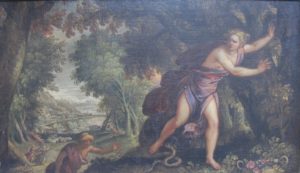Scenes from the life of the legendary Thracian poet Orpheus are regularly depicted in Renaissance art, and has some parallels in earlier Christian art with the story of David and Christ.
Broadly speaking the scenes fall into three subject areas: a) Orpheus charming the animals with his music. B) The Chase of Eurydice and c) Orpheus in the Underworld.
An oil painting to be offered at Minster Auctions on June 21 depicts an episode from that second subject area.’ The chase of Eurydice’. The picture is attributed to the painter Pauwels Franck (1540-1596) .(better known in Italy as Paolo Fiammingo) . He was a Flemish artist from Antwerp who travelled to Italy and, who for a time is said to have worked in the studio of Tintoretto in the 1560’s. The painting at Minster depicts Eurydice a wood nymph fleeing through a wooded glade , pursued by her suitor Aristaeus, a shepherd. She mistakenly steps on a snake, from whose bite she was later to die. Orpheus and other figures amongst trees beyond ,unaware of her fate.
The postscript to the story depicted in the painting is that a distraught Orpheus descended into the Underworld to search for his beloved Eurydice. The power of his music succeeded in persuading Pluto to allow Eurydice to follow him back to earth, on the condition that he did not look back at her until he reached the upper world. But at the last minute he did so and Eurydice vanished for ever. The story of Orpheus’s life, descent and return from the Underworld represented a poignant subject for a number of renaissance artists. The moral of descent into lower regions to fetch back the dead , a familiar and enduring part of Christian belief. 